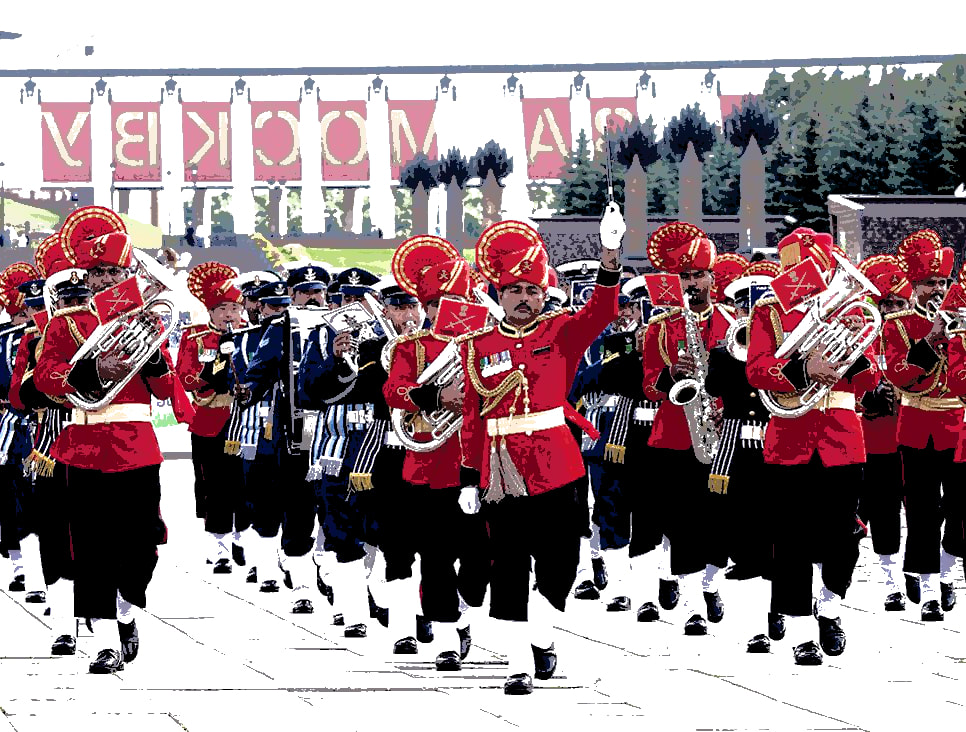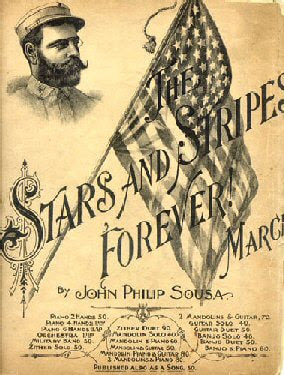|
The dictionary defines a march as "a piece of music composed to accompany marching, or with a rhythmic character suggestive of marching." This definition captures the origins of the word and genre...essentially, music designed to move bodies in coordinated steps or stepwise motion, whether in military formations, ceremonial processions, or even funeral rites. Over time, the march has evolved beyond its original functional purpose, becoming a distinct musical form. While composers of the past century may not have envisioned soldiers or parade bands when writing marches, they certainly emulated the distinct stylistic characteristics set by their predecessors. Indian Military Band March NATIONAL MARCH STYLES Many countries have developed their own distinctive, unique body of march literature, influenced by and reflective of the cultural and societal identities of their countries of origin. These marches not only embody the musical traditions and stylistic nuances of their respective nations but also serve as historical and patriotic expressions. Whether used in military processions, civic ceremonies, or concert performances, national march styles often incorporate characteristic rhythms, harmonic structures, and instrumentation that align with the broader musical heritage of a region. For example, British marches exude a sense of grandeur and measured dignity, German marches emphasize precision and power, and Spanish marches carry an unmistakable flair with their lively rhythms and expressive melodies. The evolution of these styles reflects not just musical development, but also shifts in national identity, military tradition, and cultural pride. British Marches British marches tend to have a dignified, unhurried quality, with intricate countermelodies and broad, lyrical lines. Kenneth Alford (whose real name was Frederick Joseph Ricketts) is perhaps the most widely performed British march composer, known for Colonel Bogey, Army of the Nile, and The Vanished Army. Other British marches of note include The Dam Busters by Eric Coates (originally written for a film soundtrack), and Royal Air Force March Past by Walford Davies. German Marches German marches are typically more rigid in tempo and structure, often featuring a strong polka-like feel due to their characteristic "oom-pah" patterns in the low and mid voices. Their final strains often boast a powerful, lyrical melody. Classic examples include Carl Teike's Alte Kamaraden (Old Comrades) and Hermann Starke's With Sword and Lance. French Marches French marches stand apart from their European counterparts with their emphasis on brass and percussion, often incorporating a triplet feel and accentuating the downbeat of every second measure. They fall into three broad categories: the Défilé (marching music with heavy downbeat accents), the Marche (performed by bands alone), and the Pas Redoublé (a concert march akin to a symphonic march). Louis Ganne's Marche Lorraine is a fine example of this style, and is often regarded as the quintessential French patriotic march. Camille Saint-Saëns' often-overlooked Orient et Occident is a particular favourite of mine. Spanish Marches Among the most exhilarating to perform, Spanish marches generally fall into three categories: Marcha (military-style), Marcia de Concierto (concert march), and Pasodoble (associated with bullfighting or dance). Composers such as Antonio Álvarez Alonso (Suspiros de España), Pascual Pérez-Choví (Pepita Greus), Jaime Texidor (Amparito Roca), and José Padilla (El Relicario) exemplify this tradition. Not to be overlooked is also the phenomenon of composers of other nationalities writing in the Spanish style, such as American composer George Gates (Sol y Sombra). Italian Marches Italian marches often feature lyrical, operatic melodies contrasted with fanfare-like sections or delicate soprano obbligatos. Prime examples include Eduardo Boccalari's Il Bersagliere and Davide Delle Cese's L'Inglesina. Another distinct Italian genre is the Marcia Sinfonica, a concert march rich in sweeping themes and thematic development, such as Giouse Bonelli's Symphonic Concert March. American Marches American marches typically feature contrasting strains, two or more different melodies, and a "trio" section of strains/"repeats" that offers pronounced contrasts in phrasing as well as a new key area. No discussion of marches is complete without mentioning "The March King", John Philip Sousa; however, there are other significant American march composers of note, including Henry Fillmore, Karl King, and C.L. Barnhouse, all of whom contributed immensely to the lexicon. The Stars and Stripes Forever THE MARCH IN ORCHESTRAL REPERTOIRE From the beginning of its musical life, the march has also attracted the attention of composers of more "serious" forms. Beethoven, Berlioz, Mahler, Mozart, and Tchaikovsky all wrote marches, in some cases incorporating them into their operas and symphonies. This tradition continued with composers throughout the 20th century. Although most of the following marches were not written with a wind band in mind, transcriptions exist for all but a handful, and they are worth getting to know:
*Sea Songs was originally written to be the second movement in Vaughan Williams' Folk Song Suite for wind band. It was later transcribed for orchestra by the composer. Military Band on Parade March WHY MARCHES STILL MATTER Growing up in Florida, I developed a deep appreciation for marches, largely due to the Florida Bandmasters Association’s festival requirements: every performance had to include a march. This exposed me to an enormous variety of marches, from the simple (Ted Mesang's Sturdy Men and Little Champ, Walter Finlayson's Storm King) to the challenging (Boccalari's Il Bersagliere, Chovi's Pepita Greus, Sousa's George Washington Bicentennial). As a high school band director, I came to appreciate, and even enjoy and embrace marches. I valued them for their ability to reveal an ensemble’s strengths and weaknesses quickly. Can the band articulate cleanly? Maintain balance and blend? Adjust pitch in the trio section? Shape phrases musically? The march serves as a diagnostic tool for these essential skills. Unfortunately, I’ve noticed a decline in the appreciation for marches among both students and directors. Many university wind ensembles can go an entire season without programming a single march, not even as an encore piece. Marches are part of our wind band heritage, and neglecting them means missing out on a genre rich in musical and pedagogical value. Although my days as a high school director are behind me, I still endeavour to program at least one march per semester. Marches make great openers, but they also make great encores, especially the old favourites of Sousa. Nothing can get an audience tapping their feet quite like a well-played march can, and I wish more conductors (of every level of teaching) would make a renewed effort to discover marches they may not be aware of. To aid in that endeavour, I present here some of my favourite marches...I hope you will do the same in the Comments section, so that may all learn something new. PERSONAL FAVOURITES
These are a few of my favourites...your mileage may vary, of course, depending on your musical tastes, but these are the ones I've enjoyed conducting (or performing), and can still listen to them with a great degree of satisfaction. Abschied der Slawin (also known as "Farewell, Slava") by Wassily Agapkin A great Russian march, complete with minor mode melodies, and a daunting key signature. There are a few different editions out there, but the Borgoeois one is probably the best. Fits well with a Russian-themed concert. Brighton Beach by William Latham A wonderful little march that was listed amongst the one hundred most popular marches by The Instrumentalist four different times between 1960 and 1976. Features plenty of nice melodic writing, and it isn't all that technically demanding for the musicians. Perfect for honor bands and younger ensembles. British Eighth by Zo Elliott One of my favourite marches, a regal and stately march in the British style (though Elliott was not British). Not terribly difficult technique-wise, but contains enough musical material to keep your musicians engaged. Commando March by Samuel Barber The one work for winds by Pulitzer Prize-winning Samuel Barber. Not your typical march, and quite difficult but rewarding. Hoch und Deutschmeister by Dominik Ertl A great little Austrian march that is not terribly difficult. I've used my own transcription of this march several times for honor bands, as it comes together nicely in a short amount of rehearsal time. National Emblem March by E. E. Bagley One of the standards, frequently confused for a Sousa march. Can be found in several editions. Another lifetime ago, when I was a member of the Phantom Regiment drum and bugle corps, this was one of our corps' signature marches (along with Sousa's El Capitan). March, Opus 99 by Sergei Prokofiev One of my favourite marches from one of my favourite composers. Quirky, fun, and requires a solid trumpet section (or at least a solid duo). Symphonic Concert March by Giouse Bonelli Previously mentioned above, this is certainly not a quickstep march, but rather an Italian concert march full of endearing melodies presented in operatic review fashion. It is a tad on the long side, and is quite challenging on the woodwinds. The World Is Waiting for the Sunrise by Ernest Seitz (arranged by Harry Alford) A tuneful march with an interesting backstory, having been composed first as a popular ballad in 1919, then later adapted for the University of Illinois Marching Band as a euphonium feature, before finally becoming a concert march. = = = In the more recent past, contemporary composers have continued to explore the march’s possibilities, with Don Grantham's An Uneasy March, Julie Giroux's Tiger Tail March, Jennifer Jolley's MARCH!, John Mackey's Xerxes, and Steve Bryant's MetaMarch serving as good examples. I’d love to hear from you out there - drop your favorite marches (new or old) in the comments so we can all discover new gems. Let’s keep the tradition of the march alive in our concert and rehearsal halls! |
MeMusician. Educator. Conductor. Archives
April 2025
Categories |




 RSS Feed
RSS Feed